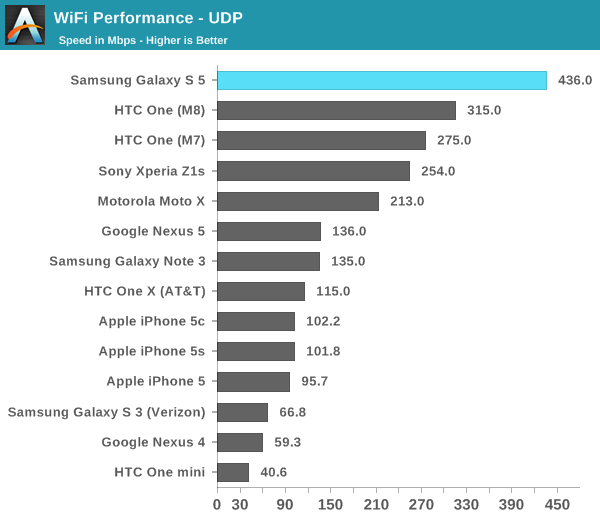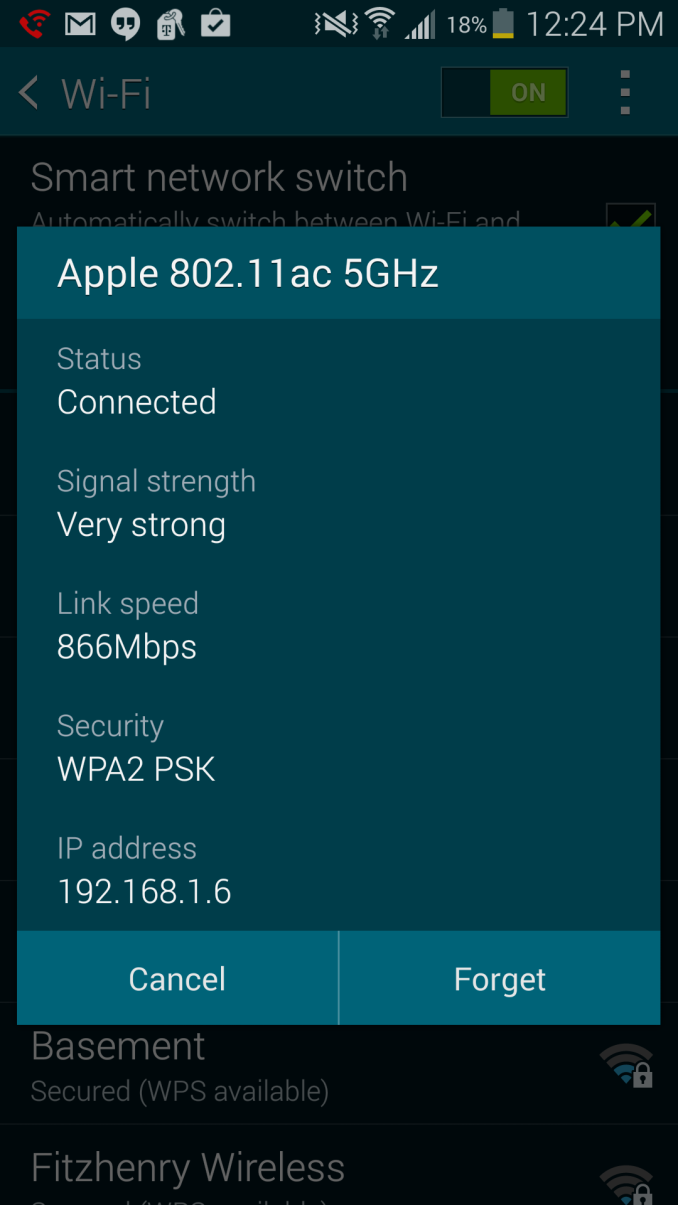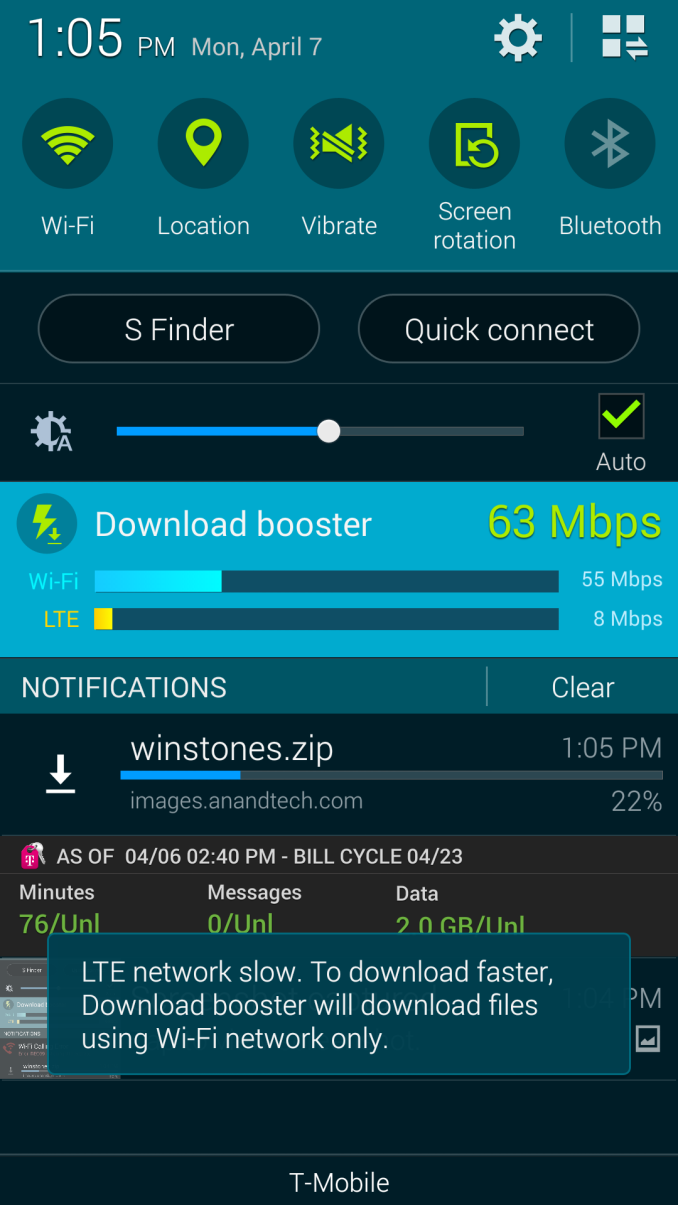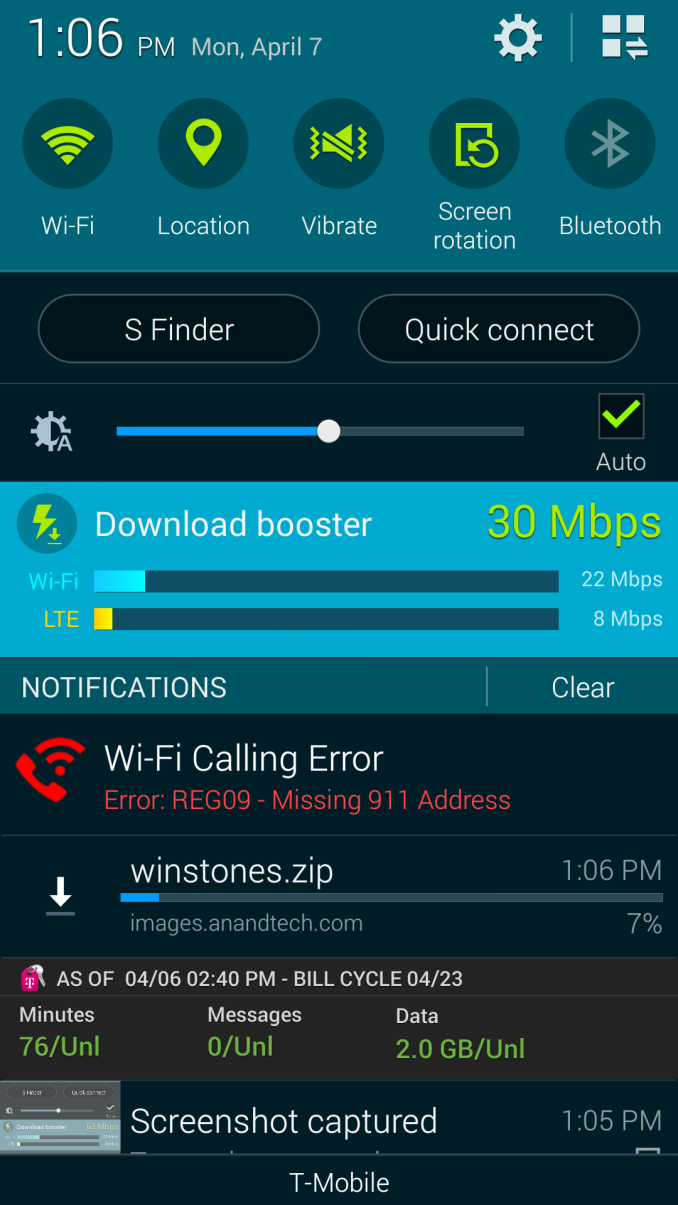Samsung Galaxy S 5 Review
by Anand Lal Shimpi & Joshua Ho on April 8, 2014 12:00 AM EST- Posted in
- Smartphones
- Samsung
- Mobile
- Galaxy S 5
WiFi, Cellular & Download Booster
At MWC this year Broadcom announced its BCM4354 802.11ac 2x2 MIMO WiFi combo chip for smartphones/tablets, which found its way into the GS5. The result is a smartphone capable of negotiating with an 802.11ac AP at 867Mbps, and transferring data at up to 436Mbps.
Although peak performance is nice, there are also power benefits to being able to transfer data quickly over WiFi (race to sleep applies to network interfaces as well).

The Snapdragon 801 features Qualcomm's integrated category 4 LTE 9x25 modem core. As I mentioned in our power analysis, Samsung also chose to include Qualcomm's QFE1100 envelope tracker (just like in the Galaxy Note 3). The GS5 is also the first flagship Samsung device to include support for 2 carrier aggregation on supported LTE networks. Samsung doesn't appear to be using Qualcomm's antenna tuner or any other RF360 components in the Galaxy S 5.
Seamless transition between network interfaces is one component of Qualcomm's vision of the future of connected devices. The problem is presently more of a software one than a hardware challenge. Samsung is beginning to explore software abstraction of underlying network interfaces with the GS5's software stack. There's now an option to prevent transitioning to WiFi networks that don't offer an improved network experience compared to your broadband connection. I haven't had a ton of time to test this feature out yet but it's something I plan on messing with more over the coming weeks.
The other big feature is what Samsung is calling Download booster. If enabled and under the right conditions, download booster allows you to combine WiFi and cellular network interfaces to accelerate large file downloads. All you have to do is enable download booster and you'll get a notification if it's active and working:
Download booster uses HTTP range requests to divide up files between the two network links. The feature can migrate data sessions from one link to another (WiFi to LTE, LTE to WiFi). Supported apps include the Play Store, YouTube, Facebook photo/video downloads, Samsung apps and standard HTTP web browsing (both Samsung's own browser and third party browsers). FTP and UDP aren't supported, nor is HTTPS.
There are other limitations as well. File downloads smaller than 30MB won't trigger download booster. Similarly, if one of the interfaces is substantially faster than the other download booster won't activate either. My home internet connection can regularly pull files down at 50 - 60Mbps, compared to < 10Mbps for T-Mobile LTE. When I was getting ~7Mbps over LTE and 50Mbps over WiFi, download booster automatically turned itself off. If I throttled my home network to 22Mbps however, download booster did its thing and gave me a healthy combined download speed of 30Mbps.
Download booster is a neat feature, although of limited use for those of us without truly unlimited high speed data plans. That being said, if you need to speed up a download in a pinch it's a great way to do that. I'm often at a press event wanting to download a benchmark onto a device as quickly as possible, usually without great WiFi or cellular reception - I can see download booster being very useful there at least.













296 Comments
View All Comments
doobydoo - Friday, April 11, 2014 - link
Hardly any phones offer different screen size options, including the Galaxy S4...OCedHrt - Tuesday, April 8, 2014 - link
What's with the constant 5s pitch. In the low light lab shot the z1s clearly has the better picture compared to 5s (less noise, similar brightness/tone) yet is not mentioned.rauelius - Tuesday, April 8, 2014 - link
No word in this review about the 16GB version only having 5GB of space for Apps? Come on, the press is the second to last bastion for consumer rights! Offering 16GB and advertising it as such when 70% of it is taken up by the OS, is as close to lying on the box as you can get. Also, SD cards are basically useless for apps at this point, so putting one on the phone, then having the press point it out is just a big middle finger in the face of the consumer.eastbei - Tuesday, April 8, 2014 - link
Well finally it is mentioned that amoled even with pentile is a better technology then IPS , LCD, etc. I personally hate pentiles but the true blacks that you get plus much better contrast, lower battery consumption and better colors make amoled the clear winner, now we just need someone else to start using them other then Samsung, I'd definintly get the g2 if it was amoled but I might be stuck with Samsung as I can't go back to an overbright backlit LCD phone.kmmatney - Tuesday, April 8, 2014 - link
One crappy thing about AMOLEDs is that they seem to get worse over time. On several older phones I have the screens are now discolored, and overall look crappy. I'll stick with IPS screens.Cyleo - Tuesday, April 8, 2014 - link
The device you refer to in your conclusion sounds a lot like the upcoming xperia Z2. I for one can't wait to see how it fares. Any plans on reviewing that device? I'm asking since I've noticed the Z1s pop up in this review. I know Sony's release schedule in the US can be a bit wonky.MrCrispy - Tuesday, April 8, 2014 - link
Why are things like removable battery, sd card, IR transmitter, HR monitor barely mentioned or completely ignored, while the fingerprint reader gets a detailed criticism? The fact is the S5 is a very well balanced phone.How exactly do the GS5 materials 'prevent it' from being a perfect device? This stupid myth about 'metal > plastic' needs to die, and its one this site likes to keep repeating. The GS5 is much more durable and waterproof compared to the 5S or M8, yet its seen as a tradeoff ?!! I don't want a metal body, plastic is shown to be better built and more durable.
kyuu - Tuesday, April 8, 2014 - link
There's plastic, and then there's plastic. Not all plastic is the same. The problem isn't that Samsung uses plastic; the problem is that they use cheap, crappy plastic.MrCrispy - Tuesday, April 8, 2014 - link
What makes the polycarbonate used by Samsung 'cheap' and 'crappy', besides subjective opinion?doobydoo - Friday, April 11, 2014 - link
The fact that it looks and feels cheap and crappy.